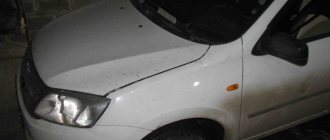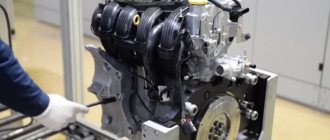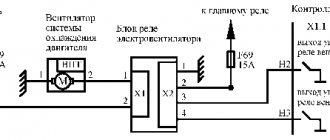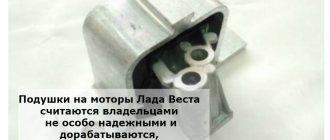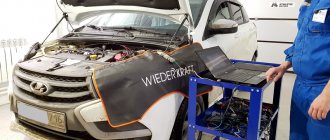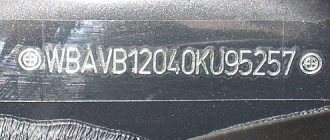Lada Vesta is a car with the ability to do software chip tuning. Both gas equipment and turbocharging elements easily fit into the engine compartment of the Lada; this is another modernization. The model appeared recently, and there are already firmware options for the Lada Vesta. Chip tuning is an intervention in the electronic control unit of the car, reflashing the program, changing the specified factory characteristics, because sedan owners are often not satisfied with them.
Correct chip tuning is rebuilding the internal combustion engine of the Lada Vesta to new parameters, and not banal ECU firmware. To advance the ignition angle, you need to install the appropriate camshaft. To work with greater power, a reinforced cylinder-piston group is required. If we are dealing with an increase in horsepower, then we need a massive and fast air supply - we cannot do without improving the intake and exhaust systems.
- Why is chip tuning possible for Lada Vesta?
- ECU firmware process
- What do chip tuners promise?
- Increasing engine power characteristics
- Optimizing motor performance
- Reduced fuel consumption
- Vesta gas pedal sharpness
- Disadvantages of Vesta chip tuning
- Is Vesta's engine life decreasing?
- You may lose your factory warranty
- Famous firmware
- Firmware improvements by AvtoVAZ
Malfunctions
When the timing belt breaks, the engine, like its brothers in the line, bends the valve.
Preface.. There are rumors, and I can’t call it anything else, that there are supposedly instructions from the factory that the fuel line needs to be changed due to the fact that there are some pulsations in the fuel rail and with a sharp opening of the throttle due to insufficient fuel, a “plug” occurs "or failure in speed. And what happens is supposedly jerking, failures during switching, and the like. My opinion on this is not even an opinion, but the belief that this is all just “Nonsense” with a capital “B”. After the correct approach and recalibration of the system, the dips and jerks practically disappeared and it became quite playful during switching. In general, everything is as it should be.
It is now possible to configure a Vesta with a 21179 engine. That is, a 1.8 engine with a phase shifter. After several hours of analysis and test drives, it became clear why people were not enthusiastic about this innovation.
The car is clearly more dynamic, unlike Vesta with the 21129 engine (1.6l-106l.s). But it is clearly far from perfect in terms of dynamics. During acceleration it is very sluggish, there are twitches and twitches at almost any throttle position, except for “slipper to the floor”. When pressing the pedal high, the damper floats incomprehensibly...
I measured the state of the inlet and outlet using an oscilloscope using a pressure sensor. Unlike factory standards, the maximum acceleration of the HF, that is, the peak torque occurs at 4800-4900 rpm.
The backpressure at the exhaust is noticeably increased, at 5600 rpm, and is already practically backing up. There is clearly something wrong with the exhaust system. Well, what about Euro 5 or 6, you have to choke it)) It was decided to replace the exhaust. After removal, I measured the diameter of the pipes.
Exit from the Catcollector
49-50mm Entrance to corrugation
43-44mm After corrugation
41-42mm and before the resonator After the resonator
37-38mm to the end. In general, it became clear why the oscilloscope showed higher exhaust pressure...
The exhaust pipes were changed to 51 diameter, the resonator and rear tank were from STT performance. The catalyst was left in place. The car clearly “came to life.” At the inlet, the oscilloscope showed large fillings; at the outlet, the pressure clearly dropped. In general, only advantages!
After recalibration, the car is simply unrecognizable. It has become very dynamic. On shifts, all the dips are removed, it picks up the revs and accelerates perfectly. The engine clearly began to “breathe”.
Due to the great complexity of the mathematical model of the calibration system, unfortunately, it has not yet been possible to put everything in place as it should be. There are minor flaws. But the problems are being solved and I hope to solve them in the near future.
In terms of dynamics, there are no complaints at all either from me or from the owner of the car. The maximum speed that I managed to reach in this car was 209 km/h. Approximately 187 km/h until the firmware is installed. But the acceleration time makes a huge difference.
And in the end, there are no problems with the fuel line and there is no need to change it! All cars drove to the village, incl. and on turbines with this line, and here on you. A stuck Euro5 engine needs fuel more than any other... On the net and on some forums, there are a lot of people who have “bought” into this business. All this is not true! There needs to be more fuel there, not more. Here's an example! This is standard firmware, the log was taken before replacing the exhaust.
Many authors of firmware calibrate according to the “January” template, UOS in + and pour fuel on top, without even looking or studying the real state of affairs in the system!
Tuning modification Lada Vesta Cross SW
A daring budget employee: Lada Vesta Cross SW with premium tuning is a universal solution for the family, and for active and even sporty driving. All work to modify the machine is similar to what we described in this article. Taking the Vesta Cross as a basis, as a more interesting option from the Lada Vesta models, and giving it to a hotel, you can achieve advantages over stock. The advantages of this process are obvious - improvements in ride quality, visuals and comfort, the ability to customize the car for yourself, making it unique. Unfortunately, there are some drawbacks; the Vesta station wagon may suffer a little during modifications. When chipping an engine, on average, 5-10% of the engine's life is lost, which is not critical, but you should know. The work done may require investments ranging from 10 to 150 thousand rubles for chipping the engine, which will lead to the dealer refusing to repair the car. Simply put, if you want a fast, cool car, you will sacrifice reliability and warranty repairs.
Source
What needs to be done with the Lada Vesta 1.6 to make it drive?
Lada Vesta with 21129 engine is the most reliable option. A car with this engine does not require oil, and the consumption is not bad at all. Only the driving dynamics leave much to be desired. One hundred and six horses under the hood and 148 Nm of torque pushing a ton of two hundred plus weight is not very convincing. For many, of course, this is quite enough, because Vesta is not a racing car, but a family sedan. But many would like it to be faster. In fact, there is already a very well-proven engine tuning that reveals its full atmospheric potential, without harming its resource one bit.
Increasing the power of Lada Vesta
Taking into account the above, it becomes clear that by modifying the standard firmware, certain properties of the internal combustion engine on the Vesta model can be improved. With all this, you should not expect a severe premium from ordinary aspirated engines with a volume of 1.6 and 1.8 without other modifications to the internal combustion engine itself, intake, exhaust, power system, etc.
So, with one chip tuning you can increase power by an average of 3-5%. Also, in the case of an in-depth option and depending on the qualifications of the specialist, this figure can be increased to 6-7%. But it is important to take into account that power is practically an increase in torque, and without making changes to the Lada Vesta engine system, it is virtually impossible to improve the torque characteristics. The only thing is that you can programmatically move the engine cut-off, which will allow you to slightly increase thrust in the upper speed range.
As you can see, we are not talking about a really noticeable increase in power after chip tuning. Then why, in this case, does the car still pull better and accelerate faster? The fact is that the main task of a chip tuning specialist is to improve the elasticity of engine operation.
In other words, if it is not possible to increase power at the physical level, then all that remains is to add traction in the low and medium speed range. In other words, the operating characteristics of the internal combustion engine are programmed to be adjusted at the same speeds that the driver uses during daily driving.
As a result, the Lada Vesta will accelerate to 60 and 100 km/h in the same time as on the “stock” firmware, but the feelings from acceleration will be somewhat different. Acceleration will be “easier” for the engine, the speed of response to pressing the accelerator pedal will improve, “brooding” will disappear, and there will be no jerks or dips during acceleration.
There is also a high possibility of reducing fuel consumption, because as part of flashing the ECU, the ignition timing (ignition timing) changes. This manipulation increases the toxicity of the exhaust as a result of an increase in the number of nitrogen oxides, while Vesta’s fuel consumption decreases slightly. But in practice, improved accelerator pedal response encourages the driver to drive aggressively, so that almost all drivers still cannot achieve true fuel efficiency.
By the way, just to improve the response to pressing the gas pedal, it is not necessary to reflash the engine control unit. It is enough to install a special corrector that replaces the real signal from the accelerator pedal and transmits it to the computer. In a nutshell, replacing the signal allows the unit to “think” that the pedal is pressed a little harder than it actually is.
Tuning the VAZ 21129 engine without turbo (25% increase in power)
The standard 1.6-liter VAZ 21129 engine, which is installed on Lada Vesta, Lada XRAY and Lada Largus, has a power of 106 hp.
With the help of a set of modifications, the power of this engine can be increased. Let's look at one example of tuning this engine, where without using a turbine it was possible to increase the power to 138 hp. Engine modifications
:
- Boring of cylinder head channels (porting). The channels were bored out to match the size of the runners on the new receiver (37mm) and the Pro-Car 4-21 spider so that there were no steps.
- A receiver from a VAZ 21179 engine (1.8L, 122hp), article number 21177100860000 was installed. To do this, the receiver itself and the air conditioner bracket had to be modified.
- USA 9.12 phase 277 shafts were installed. They are installed on the original continuous gears. No modifications are required; cutting half of the camshafts is not required. Idle speed is stable.
- The ECU was calibrated based on the results of rolling back and removing logs. The manifold flap valve is software disabled and the cut-off value is raised.
Finalization of the release
and etc.
- Spider ProCar 4-2-1, which was rolled up in thermal tape.
- Exhaust d51 mm flame arrester СBD, Yutas resonator, TurboTema muffler. We added a second bracket and a second muffler mounting pad. For a quieter sound of the muffler, a Helmholtz resonator was welded in.
- K&N zero resistance filter.
- Spark plugs NGK 4919 BCPR6EIX-11 IX Iridium.
This engine tuning allowed Vesta (R18 Motorsport 81 wheels and Sportex 215/40 R18 tires) to accelerate to 100 km/h in 8.8 seconds
(acceleration according to the passport is 11.2 s.).
Power was also measured on a dyno. As a result, we got a result of 138 hp.
and moment 182 N.m.
According to the owner of this car, compared to the standard configuration, the car drives briskly in the city and especially on the highway, despite the heavy 18-wheel drive wheels. But naturally the “lower classes” are weak.
Approximate prices
:
- engine tuning - 40 thousand rubles.
- tuning of the exhaust system - 25 thousand rubles.
Let us remind you that the real power of the standard 1.6-liter Vesta engine is about 112 hp. (see measurements on a dynamometer). That is, a set of modifications made it possible to increase engine power by approximately 25% (26 hp).
Lada Vesta turbocharged from the manufacturer
In general, the Lada concern has long presented to the world its version of a sports car with a Turbo Vesta turbocharger with a powerful engine, the power of which is 350 hp. It was made specifically for participation in circuit racing, and therefore it came with extended wheel frames for wheels with low-profile tires.
New Lada: Everything that is known about galvanizing the body of Lada cars: Vesta, Granta, X Ray and Largus
How successful the project was can only be judged by racing drivers. All other car enthusiasts have to wait until the turbine from the factory finally goes on sale and becomes available to everyone. It is now known for sure that the turbocharged engine for Vesta will be assembled by the French company Renault and it will increase the car’s power to 150 hp, which is not bad , compared to the current maximum of 122 hp.
Is it worth doing chip tuning of Lada Vesta: disadvantages and possible consequences
Currently reading: Symptoms of air leaks in the intake manifold and check
Jul 11, 2020
Ford Focus 2: replacing the cabin filter with your own hands
Jul 11, 2020
It is quite obvious that many owners are interested in how firmware changes affect engine life, whether the warranty on the new car is still valid, etc. First of all, you need to understand that the chipped engine of the Lada Vesta and any other car will have a shorter lifespan compared to the stock version.
At the same time, flashing only one cannot significantly reduce the life of the internal combustion engine. More precisely, the reduction in engine life is around 5-7%. However, this can be stated if the chip tuning was performed by professionals, high-quality software was used, etc.
The high probability of accelerated failure concerns the gearbox rather than the engine, since the load on the gearbox will inevitably increase
You should be especially careful when chipping a Lada Vesta with an AMT robotic gearbox. To implement the task correctly, it is also necessary to modify the “robot’s” firmware, and in this case additional difficulties arise
As far as the vehicle warranty is concerned, no one will be connected to the ECU as part of normal maintenance. However, if problems arise with the engine or gearbox, and the client decides to apply for warranty service, the fact that the factory firmware has been changed will be established. It is logical that this will serve as a strong argument in favor of the dealer completely waiving its warranty obligations.
Some car enthusiasts practice a method of saving the factory program, which is “poured” back into the ECU of a warranty vehicle if problems begin with the engine or gearbox. However, this method also does not always work.
You also need to take into account that the factory firmware was tested by specialists in the factory; the internal combustion engine with such software was tested in a variety of conditions. As for alternative firmware, in any case it will be an individual modification of the standard program.
Large tuning studios, in the process of creating firmware, necessarily “test” the program by installing the car on special stands, reading various data, monitoring the operation of the engine in all modes, etc. Often the engine of test samples is even disassembled and its condition is visually assessed.
Also, often after chipping, an additional “break-in” is practiced online, that is, correction occurs directly while driving in real time. Such studios provide a guarantee, and such chip tuning itself can be considered safe. The only thing that makes sense is that the price of reflashing the ECU will be quite high.
Given the high cost of chipping, professionals, as a rule, will always have more affordable offers. At the same time, you need to be prepared for the fact that such firmware is “no name”, that is, without indicating the author of the assembly, in this case no one tests or tests it. There are also no guarantees.
In practice, large studios usually warn about possible risks for the car owner, small organizations can only partially address this issue, chipmakers from the garage will simply “upload” unknown software at their own peril and risk. It’s good if garage craftsmen carry out additional running-in and calibration, since many do not even do this. Moreover, in the latter case, the warranty ends when the car leaves the garage.
As a rule, after using programs that are freely available, there are frequent cases of increased fuel consumption, floating speed, rapid failure of the catalyst, etc. Sometimes, in order to increase power, non-professionals “drive” the engine into operating mode only on rich mixtures and shift the OZ so that the engine operates on the verge of detonation.
It also happens the other way around, when the customizer practically does not change important parameters in order to protect himself from possible risks. However, the result of such chip-tuning is almost invisible, although you still have to pay for the service.
Change of oil
AvtoVAZ recommends using synthetic oils for its internal combustion engines. The choice of which oil to pour into the Lada Vesta engine should be based on the season: the oils recommended by the factory are synthetic 5W-30 and 5W-40, they are poured when the car is released from the assembly line, and they provide optimal conditions in average Russian conditions.
Oil selection diagram based on ambient temperature:
The oil manufacturers recommended by AvtoVAZ are Rosneft and Lukoil; their lubricants have factory approvals, which guarantees full compatibility and reliability of the lubricant. Among foreign ones, we can recommend the products of Mobil, Shell (Helix HX8 oil) and Motul (Specific DEXO s2 fluid).
Important: the first oil change on a new car should be done after 1.5-2 thousand km. mileage, since the “factory” fluid is essentially filled in for break-in. The interval between the first and second replacement is 15 thousand, according to the regulations, but in fact it is better to do it twice as often.
For the Lada Vesta, changing the engine oil is standard and can be done by yourself:
- the engine filler plug is unscrewed (with the internal combustion engine switched off);
- the crankcase protection is dismantled, if any (you need to remove 13 bolts);
- the drain plug is unscrewed (you should first place a waste container under it);
Important: Vest with an AMT gearbox has a different crankcase and a different size drain plug.
- after draining, the oil filter is removed (in this case, you will most likely have to disconnect the plug from the crankshaft sensor and remove the sensor itself), using a special puller or by piercing it with a screwdriver, which then serves as a lever for rotation;
- Next, you should wait for the remaining oil to drain, install a new filter (after pouring about half the oil into it), return the sensor and plug to their place;
- After this, the required amount of oil is poured into the filler neck, the level of which is controlled by a dipstick.
This is followed by the engine starting and control measurement after several minutes of idling. If necessary, oil is added or, conversely, excess is removed.
We would like to share our opinion on the topic of tuning. These are our thoughts and they may differ from your ideas. In the article we will describe the topic of refining the sedan, Lada Vesta tuning outside and inside! I think many car owners have asked the question: “How to optimally pump up a car with minimal investment?” Let’s find out.
First, let's understand what makes sense to put on the car. To make the front of the car more aggressive, I would choose the Lada Vesta Xmug front bumper. This is an interesting and practical bumper; it does not interfere with driving on our rough roads. Prices for it start from 5,400 rubles. I installed door sill covers in the form of yarplast (prices from 650 rubles), which will greatly increase the practicality of the car, making it easier to clean the interior. We will try to do all the tuning ourselves as much as possible. This saves money, and who doesn’t like to tinker with their favorite car for a couple of hours in the garage?)
The next stage would be improvements to the optics, headlights and taillights - an essential part of the car improvement process. All auto parts would be bought at a regular tuning store; there shouldn’t be much difficulty in finding them. Let's imagine that the car is black, and I think that the elements should be installed in black. A white car has a choice between white elements or individual black inserts. The decision to “upgrade” the Lada comes after realizing that the car’s stock characteristics are extremely lacking. The car has fairly calm, perhaps even “family” lines, and not the highest dynamics. I think the main popularity of tuning for Vesta is connected with this. Last on the list, but not least in importance would be 18-inch wheels; they look nice on the car. The first stage of refining the Lada has been completed, we need to start something large-scale.
Why is chip tuning possible for Lada Vesta?
Vesta is available in two versions: with a 1.6 (106 horsepower) and 1.8 (122 horsepower) engine. Both power units are quite powerful, their preset factory torque parameters are “averaged,” and chip tuning optimizes engine performance. VAZ makes engines with a small volume, because people do not want to pay a large transport tax. People want an "average", practical car. Squeezing maximum power from the engine is not the prerogative of AvtoVAZ. There are Euro 5 environmental standards that are not compatible with chip tuning. From the factory, the torque is adjusted so that the car drives from the bottom; this is necessary for urban driving. Chip tuning can spread the torque over the entire operating range of the engine.
Renault Nissan HR16DE
This engine has quite a long history and was created in 2004 based on the Renault K4M power unit. The main goal of the development was to increase efficiency and introduce advanced technologies - automatic change of gas distribution phases, timing chain drive, gas rotator on the intake shaft, etc.
The engine has proven itself to be unpretentious and reliable, which led to its choice for equipping VAZ XRays.
This is what it looks like under the hood:
In 2015, AvtoVAZ mastered the assembly of these engines, and at the end of the year they equipped the new Lada XRay hatchback. We also know about plans to install this internal combustion engine on Vesta.
The engine cylinder block is aluminum. The engine develops power up to 110 forces, with a volume of 1.6 liters.
An important feature of this engine is the timing chain drive, which, coupled with other improvements, eliminates the problem of bent valves. The engine can be powered by 95 and 92 gasoline, and complies with Euro-5 econorms. The resource, like that of VAZ class brothers, is 200 thousand km.
Common engine problems
The set of characteristic problems for 21129 has remained unchanged since the days of 21126 from the Lada Priora, of which it is a descendant. Engine tripping may occur: the reason often lies in clogged injectors, faulty ignition coils or spark plugs. Sometimes there are situations with valve burnout.
Another common problem with most 16-valve VAZ units is floating speed. Possible causes of manifestation:
- breakdown of the mass air flow sensor;
- throttle valve contamination;
- failure of the damper position sensor;
- Broken idle speed controller.
Another malfunction is that the engine may not reach operating temperature. The reason often lies in problems with the thermostat, or simply low temperature outside (then the engine needs insulation).
The engine refuses to start: you should check the electrics - coils, battery, spark plugs. The fuel pump or gasoline pressure regulator may fail, or the fuel filter may become clogged.
Knocking and extraneous noises from the engine compartment: hydraulic compensators are worn out, pistons, main and connecting rod bearings may also need to be replaced.
Engine vibration: the idle speed control or the armored wire is faulty; another probable cause is dirty injectors.
Problems VAZ 21129
1) Overheating. The problem lies in the thermostat that is failing. In winter, another problem may occur: the engine takes a long time to warm up.
2) When the timing belt breaks, the pistons bend the valves. It is necessary to regularly monitor the condition of the timing belt to avoid breakage.
3) Triple. The injectors are clogged or the spark plugs or ignition coils are faulty.
4) Knocks. Knocks in the engine come from hydraulic compensators.
Tuning
You can read about how to increase power here. If you want to increase the power a little, then you can do chip tuning and install a 4-2-1 exhaust system on a 51 mm pipe.
What do chip tuners promise?
For a regular Lada naturally aspirated gasoline engine, you should not expect a large increase in power - no more than 10%. A car with a turbocharged engine will have a noticeable increase in horsepower. The operation of the power unit will feel elastic, and the gas pedal will become more receptive to driver signals. With an increase in ignition timing, fuel consumption will decrease.
Increasing engine power characteristics
This is the main direction of tuning the heart of the Lada. It is impossible to increase torque without interfering with the motor design. Or it’s possible to add traction in the low and middle speed range, move, or completely remove the cutoff in the upper range. Chip tuning eliminates failures when turning on the air conditioner, the car accelerates more easily and “thinks” less. Everything about the place feels like an increase in engine power. In fact, it is small, approximately 5% (on expensive and competent firmware - up to 10%). The price for tuning ranges from 2500 rubles to 80 thousand. For this money you will get a complete upgrade of your car. Tuning the Lada Vesta engine depends on the program being filled in and the level of the technician.
Optimizing motor performance
With the factory settings, Vesta is prone to slow acceleration, a “stiff” ride, and one gets the feeling that the car is having a hard time driving. It does not immediately respond to a greater opening of the throttle with the gas pedal; people say: “the gas is dull.” This becomes noticeable after proper chip tuning. Well-written firmware eliminates dips during acceleration, makes the pedal more sensitive, and eliminates jerking during sudden changes in speed. The operation of the internal combustion engine becomes flexible, Vesta drives noticeably easier.
Reduced fuel consumption
The calibration of Vesta engine operating parameters provides for changing the ignition timing to a larger one. An increased ignition timing significantly reduces the consumption of gasoline or other fuel. With the new OZ, less combustible substance is required, however, it burns (oxidizes) longer. This releases more harmful nitrogen and oxygen compounds (oxides) into the atmosphere, resulting from the combustion or explosion of fuel. This does not meet the environmental standards of our country and even more so of the EU countries.
Vesta gas pedal sharpness
Lada owners are unhappy with the responsiveness of the accelerator pedal. By installing chip tuning on a car, the problem is solved. The fact that the electronic gas pedal slows down is not a reason for chip tuning. In principle, the electronic pedal cannot help but brake. That's why it's electronic. The ECU decides whether to go faster or not. By pressing the pedal, a signal is sent to the controller; it has a preset program. He cannot leave the program and opens the throttle valve completely when the engine reaches the required speed. In the case of a mechanical pedal, the valve opens when pressed whenever you want it. To make the gas pedal responsive, an electronic corrector is installed in front of the ECU. The corrector is a “fake” - it gives a signal that the pedal is pressed harder than it actually is, providing the necessary connection between the driver and the accelerator.
Famous firmware
What firmware for Vesta optimizes engine performance? Well, first of all, the author is known. Such programs have a guarantee; in case of problems with the engine (and they are rare), you contact the manufacturer. Such firmware is tested on cars and engines displayed on stands. The author makes the product competently, otherwise he would not have announced the name. Secondly, the firmware must be developed for the car. Universal for all cars, or does not fit with a similar model. This should be chip tuning for Lada Vesta.
A good program gives a big increase in engine power. Its price differs from “no name” chip tunings. We will offer several options for proven firmware.
When it comes to tuning Vesta, the first thing that comes to mind is Paulus. Chip tuning with this firmware reduces acceleration time and reduces fuel consumption. The changes are aimed at increasing traction in the middle engine speed ranges, changing the ignition timing, fuel supply and others. The advantage of Paulus chip tuning is the ability to disable the lambda probe control sensor. It is important if you are planning to remove the catalyst (to create more power, or simply because it is clogged and a new one costs money). Some owners notice poor detonation and have to increase the octane number of the fuel being poured. After all, the ignition timing has changed, but the air intake system remains the same.
Chip tuning from Ledokol changes the idle speed, the maximum throttle opening value, changes the throttle angle (there is a lot of controversy on this issue, some claim that the angle becomes smaller than the standard one) and fuel supply. The increase in acceleration with the firmware is small; in first gear you can reach 7000 rpm or higher.
Chip tuning from Adakt is good for robotic gearboxes. There is better controllability of the Lada robot in manual mode, smooth and quick switching of speeds. The sensitivity of the accelerator pedal improves, the gaps between second and first speeds disappear, and power increases along with acceleration. Reviews about the reduction in fuel consumption are different. For some it decreases greatly, for others it increases. It has to do with the driving style of the car driver.
The RSW firmware for the Lada Vesta focuses on the car's handling. Gas pedal response and acceleration are noticeably improved. In addition to changing the usual characteristics (as with similar firmware), the stabilization system is weakened, which makes it possible to drive off with a slip. Among amateurs and professionals of chip tuning, there is an opinion that, in fact, the calibration angles remain the same, only the throttle opening phase has been changed.
Remove Lada catalyst
If you remove the catalyst on a Lada and reprogram the ECU to the Euro 2 standard, then a number of problems associated with this unit in the car will be solved at once. Firstly, catalysts quickly fail, they become dirty and begin to retard emissions. This means it harms the engine and interferes with the normal operating cycle of the system. Secondly, an unusable catalyst causes a software error, which is transmitted to the ECU by the lambda probe. This nuance also causes engine failures, since the normal algorithm of ECU commands is disrupted. Therefore, if you correctly remove the catalyst from the exhaust system, and then delete the memory and information about it in the computer component of the Lada, then errors will no longer arise from anywhere. In our center you can 100% order the careful and correct removal of catalysts for Lada Kalina, Lada Granta, Lada Priora, Lada Vesta, Lada X Ray, as well as the corresponding re-flashing of the ECU, which will be the chip tuning of the car.
Remove particulate filter Lada
If your Lada does not have a catalyst, but a particulate filter, this will not change the situation. Unusable soot also harms the car, takes up unnecessary resources and causes a number of software errors with its inadequate filtration. Through chip tuning of the engine, Hephaestus masters remove the particulate filter using the same scheme as removing the catalyst. Therefore, for this car repair, you can contact us with either a complete set containing a particulate filter or one with a catalyst installed. The main thing is that we guarantee correct and safe chip tuning! We indicate this in the service agreement. Our service technicians already have quite a lot of experience in improving VAZ cars. Therefore, for high-quality chip tuning, catalyst (particulate filter) removal and profile tuning of car electronics on your Lada, you can always contact us with confidence in a positive result. We will carry out routine engine repairs, repair the exhaust system and add power to your car. So after chip tuning, the gas pedal will pleasantly please you!
Engine 21129
This power unit belongs to the family of sixteen-valve 4-cylinder injection engines and develops power up to 106 horsepower. The Vesta 21129 engine is powered by gasoline of a grade no lower than AI-95.
Other characteristics:
| Name | Meaning |
| Number of cylinders | 4 |
| Location | Row |
| Volume | 1.6 l. |
| Timing drive | Belt |
| Bend valves when belt breaks | Yes |
| Weight | 109 kg. |
| Ignition | Electronic |
| Environmental Compliance | Euro 5 |
The Lada Vesta engine resource declared by the manufacturer before overhaul is 200 thousand km. mileage
The engine was a modification of the old VAZ unit 21127, and when the first Vestas rolled off the assembly line, many continued to believe that there was a familiar “one hundred and twenty-seventh” under the hood. The engines are similar in many ways: they have the same cylinder blocks made of cast iron, crankshafts, pistons and connecting rods identical to the cylinder head. Changes have been made to:
- air supply line;
- exhaust system;
- electronic control unit.
This was done in order to bring environmental characteristics to Euro 5 standards. The engine power remained the same, and, unfortunately, the typical “disease” remained - bending of the valves when the timing belt breaks.
The unit is equipped with a manual and robotic gearbox. Engine type:
Vesta engine types.
Vesta has the following configurations, differing in the set of options: Classic, Comfort and Luxe. Available modifications:
- Cross – 5-seater sedan with increased cross-country ability;
- CNG – allowing the use of both gasoline and compressed gas;
- SW – station wagon with 5 seats;
- SW Cross – version of SW with increased cross-country ability.
The following engines are found on Vesta:
- VAZ 21129;
- ·VAZ 21179.
The engine capacity of the Lada Vesta is 1.6-1.8 liters. It is possible to equip it with a localized Renault-Nissan HR16 engine, but they are not available for sale. To find out which engine is on the Lada Vesta in a particular case, you should refer to the documentation and technical characteristics of the car.
Let's take a closer look at them.
Lada Vesta turbocharged from the manufacturer
In general, the Lada concern has long presented to the world its version of a sports car with a Turbo Vesta turbocharger with a powerful engine, the power of which is 350 hp. It was made specifically for participation in circuit racing, and therefore it came with extended wheel frames for wheels with low-profile tires.
New Lada: Everything that is known about galvanizing the body of Lada cars: Vesta, Granta, X Ray and Largus
How successful the project was can only be judged by racing drivers. All other car enthusiasts have to wait until the turbine from the factory finally goes on sale and becomes available to everyone. It is now known for sure that the turbocharged engine for Vesta will be assembled by the French company Renault and it will increase the car’s power to 150 hp, which is not bad , compared to the current maximum of 122 hp.
Refinement of the Lada Vesta engine
Let's start with the fact that chip tuning of the Lada Vesta or any other gasoline or diesel car often remains a controversial issue. At the same time, this topic is actively discussed among owners of the Vesta model.
The fact is that chip tuning (reflashing the electronic engine control unit, ECU) is one of the simplest and most affordable ways to increase engine power, improve throttle response and elasticity of the internal combustion engine, increase fuel efficiency, as well as a number of other performance indicators.
Let's start with the fact that the Lada Vesta is a fairly large car in terms of weight and dimensions, and is also available with two naturally aspirated gasoline engines, which have a displacement of 1.6 and 1.8 liters. with a power of 106 hp. and 122 hp respectively. It is quite obvious that the desire to increase the power of the internal combustion engine without major modifications to the power unit itself is completely justified.
In practice, many Vesta owners, after chip tuning, note that the car began to drive better, the desired pickup from the bottom appeared, the “failure” was felt less or actually disappeared when the air conditioner was turned on. Also, some drivers, after reflashing the ECU, reliably record an increase in power, which, on average, ranges from 3 or 5 to 15 hp. without any intervention in the motor structure.
However, with all the advantages, doubts of this kind also arise, whether such manipulations can be considered safe, how chip tuning will subsequently affect the resource of the power plant, and also why the AvtoVAZ plant does not immediately increase the power programmatically, if such a possibility exists.
Let us immediately note that in addition to power, the plant also takes into account the engine’s compliance with environmental standards, which are constantly becoming stricter. As a result, the engine is for the sake of the environment. You should also remember about the transport tax, which is calculated based on the power of the internal combustion engine. It turns out that from this side the less powerful unit looks more attractive to the buyer.
We can also add to this that the basic firmware is a kind of “average” option in all respects. In practice, this means that the manufacturer makes little effort to get the most out of the engine. The main thing is that the power of the power plant fits into the declared passport data, although often practical measurements show that the real power is even less.
Firmware improvements by AvtoVAZ
There are no factory versions of software for the Lada Vesta with increased power characteristics. But AvtoVAZ plans to improve it, although only in relation to the AMT Lada.
Testing of the new firmware is already underway on cars with an automated transmission (robot). Perhaps she will appear soon. This is the “creeping mode” firmware. The point is that when you release the gas pedal, the car starts moving at idle speed, like an automatic machine.
There is no final opinion on the benefits and necessity of chip tuning of the Lada Vesta. It is up to the owner of the car to decide whether it is worth installing new software on the car or not. In this article you read how to do it correctly so that there is less disappointment about it.
General tuning Vesta SV
In terms of general tuning, Vesta, like many other cars, gives you the opportunity to go wild. If you have the desire, time, opportunity and money, then you can radically change your car by performing the following operations:
- installing linings, deflectors, racks, protection, spoilers;
- carry out tuning of the power unit, interior, brakes, body, transmission, suspension;
- replacing the seat upholstery
- by reducing the brightness of the standard MMC backlight and so on.
But to start changing something, it’s worth figuring out whether there is any point in certain modifications. When working with a sedan, you can change its appearance by replacing the installed bumper with the Vesta Xmug model. From the front it will become more aggressive and sporty, this does not interfere with driving even on bad roads, so it is a practical and very interesting option. The cost of modification is about 5.5 thousand rubles. You can increase the practicality of a car with the help of yarplast type door sills, the cost of which starts from 650 rubles. Installing them makes cleaning the machine easier. For many drivers, improving optics is a must, as is installing 18-inch wheels.
But these are all fairly simple solutions. But more radical changes require a serious approach:
- Door sill, bumper and external styling spoiler. The main changes here are only visual. The body kit costs adequate money, but you need to start with yarplasts. Installation of Xmug bumpers makes the appearance of the model even more interesting and vibrant.
- Working with the salon. There are many more questions here than with appearance. Poor sound insulation and impractical materials constantly remind of themselves. The fewest questions arise about the dashboard. Many people recommend replacing the base armrest right away, but it is inexpensive. It is better to install rubber pads on the carpet.
- Turbine. This cannot be done without technical improvements. Without such tuning, all changes will be incomplete. The first thing you need to do is install the turbine; here you will need to contact specialists to install the part and configure the option. It is recommended to purchase a complete kit at once.
Finally, you can work on the exhaust system, but this is only for those who love the “animal roar”. By removing the catalyst, the sound becomes bright and aggressive. But sometimes it is necessary to work with the system if the exhaust “howls”. This indicates that the corrugation has deteriorated and a resonator with a reinforced element will need to be installed. And the spider exhaust manifold will help make the sound as pleasant as possible.
Information is out of date. Archive
When compiling the material, photographic materials were used from the Internet resources Injector-VAZ, SVR Conversions, Team-RS, Dvigateli-VAZ.ru, MotoProm, Kartuning, OKB "Dynamics" and many others.
Some materials may be duplicated with the main content of the site. This is a very popular article. It, with bills (but mostly without), was stolen and posted on a good dozen “tuning” sites and in the automotive press of the state of Ukraine. (I’m even somewhat flattered that so many people steal from me - it means there is something. In this regard, I allow free reprinting without reference to the original source for all representatives of sexual minorities of the passive type).
You judge the quality, “which two words themselves cannot connect about what is offered to people for a lot of money. People, be careful! :
Meager numbers of the roller stand.
How many horses can you squeeze out of 8 cl. serial engine 21083. Tests on a roller stand for a VAZ 2108 - 17 car. 10 . 2002 held with the participation of Uncle Sam.
- Engine 1, 6, camshaft and cylinder head cross
- Sports receiver, 52 mm DZ, zero resistance filter, free exhaust
- Without a flow meter, additional corrections for atmospheric pressure and temp. air.
- Oxygen sensor. DPKV - on the flywheel. Rev limiter – 8500
- Standard gearbox
What happened (data on VSKh from the videos). Maximum power 126 hp at 7400 rpm and speed 206 km/h. Naturally, without taking into account Cx, because there is no wind on roller skates :).
Then the serial injectors simply refused to work (the linear range ended).
Increase in working volume
The most common option for increasing the working volume to 1600 cc. cm is to increase the piston stroke to 74.8 mm (standard - 71 mm) by replacing the crankshaft and pistons. There are several options here
a) “Forged” pistons, common sizes 82, 0, 82, 4, 82, 5 84, 0 mm of various classes. “Forged” pistons come in both regular and T-shaped shapes. The latter are much lighter in weight. b) Standard pistons that have undergone special mechanical modification. c) Using pistons 21213 with mechanical modification and replacement of connecting rods for a “floating” piston pin.
In addition to the most common crankshaft with a piston stroke of 74.8 mm, there are also CVs with a piston stroke of 75.6 (serial from 1.6) 78, 79, 80 and even 84 mm. By using these crankshafts, volumes from 1580 to 1862 cc can be obtained. cm, and almost all configurations can be accommodated in a block of standard height. In this case, naturally, the “torque” of the engine suffers due to non-optimal R/S.
External styling spoiler, bumper and door sills
Tuning Vesta, in our opinion, begins with visual changes. It is more pleasant to see and feel the changes first than to feel them while actually driving the car. Fortunately, the body kit of the domestic Lada Vesta costs adequate money. We would start refining the interior with yarplast, we are tired of the constantly dirty coating, but here we just wipe it with a rag - it shines. Rear tuning for the Lada Vesta bumper involves installing Xmug, there is the same bumper in front, together they look harmonious. Recently, sedans from VAZ have begun to please with their appearance - Vesta is direct proof. It’s far from ideal, it requires a lot of work on styling and on the engine, but it’s a level higher than what it was before. The appearance of the body is acceptable, I just want to see a trim, sporty look. It will suit the average user, but there is no tuner. We think it is necessary to change the front bumper. It’s too boring and there’s also a rook in the middle.
Lada Vesta body tuning
The exterior can also always be modified beyond recognition - there are plenty of plastic parts for this in any car shop. The most common modifications to the Lada Vesta body are the following tuning options:
Tuning the radiator grille of Lada Vesta. The updated radiator grille gives a unique look to the front of the car.
But it is important to be careful - manufacturers of such parts do not always take into account the throughput of the gratings. Body kits around the perimeter of the body. Do-it-yourself improvements to Lada Vesta body kits are a great way to give your car individuality, but it is important to understand that dirt and moisture often accumulate under the plastic, which can cause corrosion.
Therefore, before installing body kits, be sure to do high-quality anti-corrosion treatment. Tuning optics for Lada Vesta. Read about this modernization option below.
